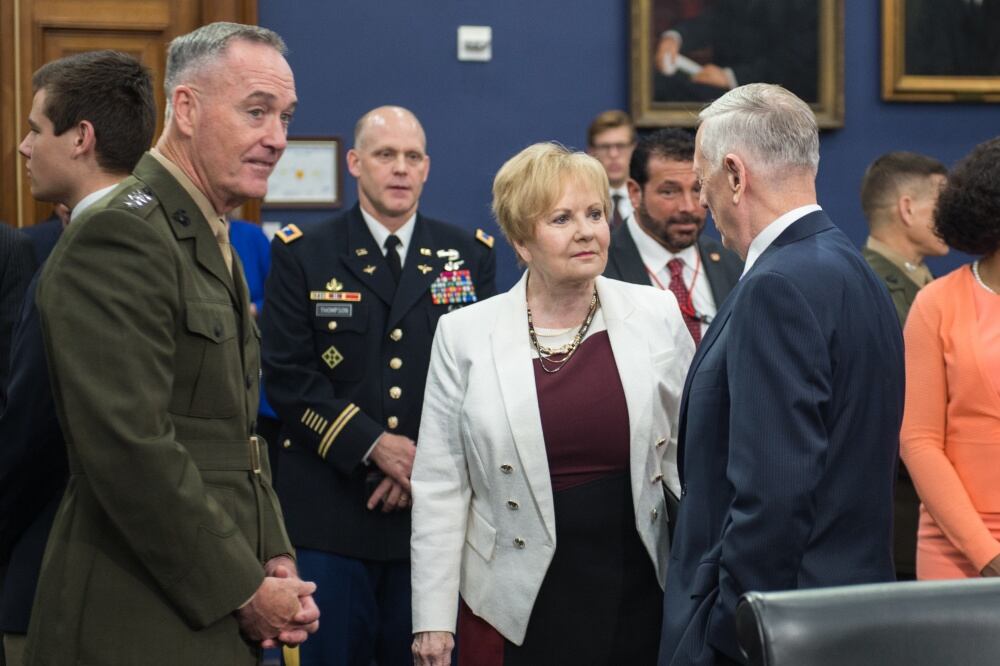WASHINGTON — Beyond the 77 F-35 Joint Strike Fighters authorized by the 2019 defense policy bill, congressional appropriators are adding another 16 for a total of 93.
Congressional conferees on Thursday finalized a $674.4 billion defense spending bill for next year packaged with funding for the departments of Education, Labor, Health and Human Services, or Labor-HHS — and a continuing resolution through Dec. 7 for some other parts of the government.
As usual, appropriators used their annual defense spending bill to offer tweaks to the existing shopping list for military hardware from the previous version, which President Donald Trump signed into law last month.
The new compromise spending bill, which trumps the authorization bill, buys three littoral combat ships instead of two and 13 Bell-Boeing V-22 Ospreys instead of seven — among other differences.
The Navy and Marine Corps continue to invest in vertical takeoff aircraft and announced a $4.2 billion contract for dozens of new V-22 Osprey tilt-rotor aircraft just weeks ago.
But the Navy has been trying to cap its purchases of the LCS amid the program’s troubles. In June, White House budget director Mick Mulvaney told appropriators three ships were two too many.
“These two additional ships are not needed,” Mulvaney said in a memo. “One LCS in FY 2019, when combined with the three funded in FY 2018, will keep both shipyards supplied with enough work to remain viable for the Frigate competition.”
RELATED

One LCS manufacturer is Austal, in Mobile, Alabama, which happens to be the home state of Senate Appropriations Committee Chairman Richard Shelby.
For that matter, House Defense Appropriations Subcommittee Chairwoman Kay Granger’s Fort Worth, Texas, district includes the massive Lockheed Martin assembly plant for the F-35.
The House and Senate are expected to pass the measure before the start of the fiscal year, Oct. 1, to avoid the optics of a government shutdown ahead of midterm elections in November.
“We expect to have a good, strong support in this, looking at job base as well as military strength. And I'm proud of the bill, and I think those who voted for it will be proud of it too,” Granger said Thursday.
Appropriators otherwise took a special interest in weapons and munitions RDT&E, adding $482 million to the Trump administration request for $40 million in related categories. Lawmakers added another $508 million for hypersonic prototyping that the administration did not include in its budget submission.
Again, this looks like good news for Lockheed. The U.S. Air Force picked the defense giant last month to design a second hypersonic weapon prototype, setting it up as a hypersonic powerhouse.

On the flip side, the bill includes language echoing the FY19 National Defense Authorization Act’s pause on sales of F-35s to NATO ally Turkey, pending a new assessment of U.S.–Turkey relations. The move bucks Defense Secretary Jim Mattis who has warned this would cause an international supply chain disruption, as the aircraft is co-produced with Ankara.
The bill includes $606.5 billion in base discretionary funding, an increase of $17 billion above the FY18-enacted level, and it parks $67.9 billion in off-budget Overseas Contingency Operations account. Overall, it hews to the two-year spending deal that eases statutory budget caps to allot $716 billion to national defense in 2019.
Military personnel and pay totals $143.2 billion (which includes a 2.6 percent pay raise for troops); operations and maintenance totals $243.2 billion (about $3 billion less than the NDAA); research, development test and evaluation totals $94.9 billion; and procurement totals $148 billion.
Joe Gould was the senior Pentagon reporter for Defense News, covering the intersection of national security policy, politics and the defense industry. He had previously served as Congress reporter.





